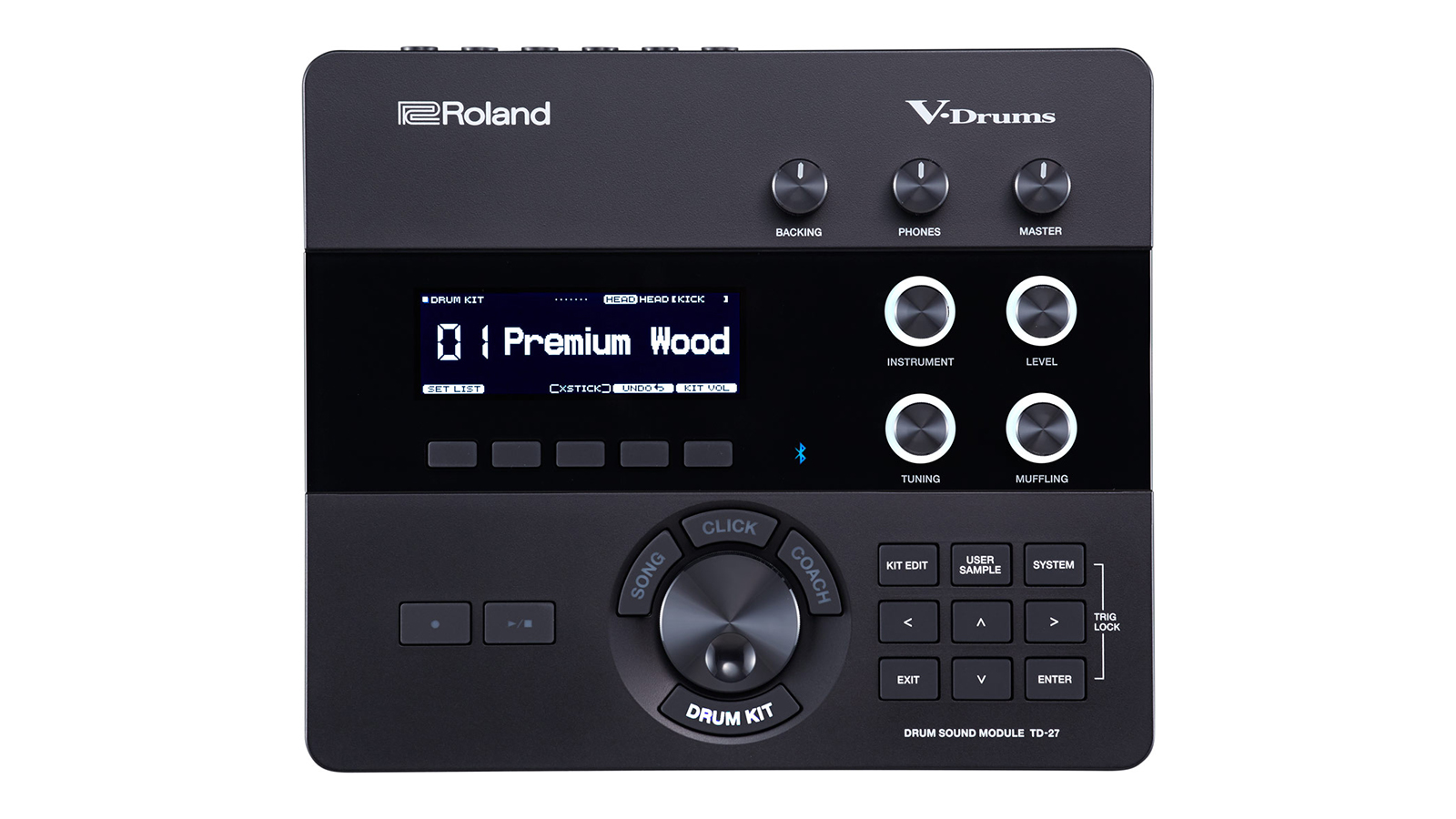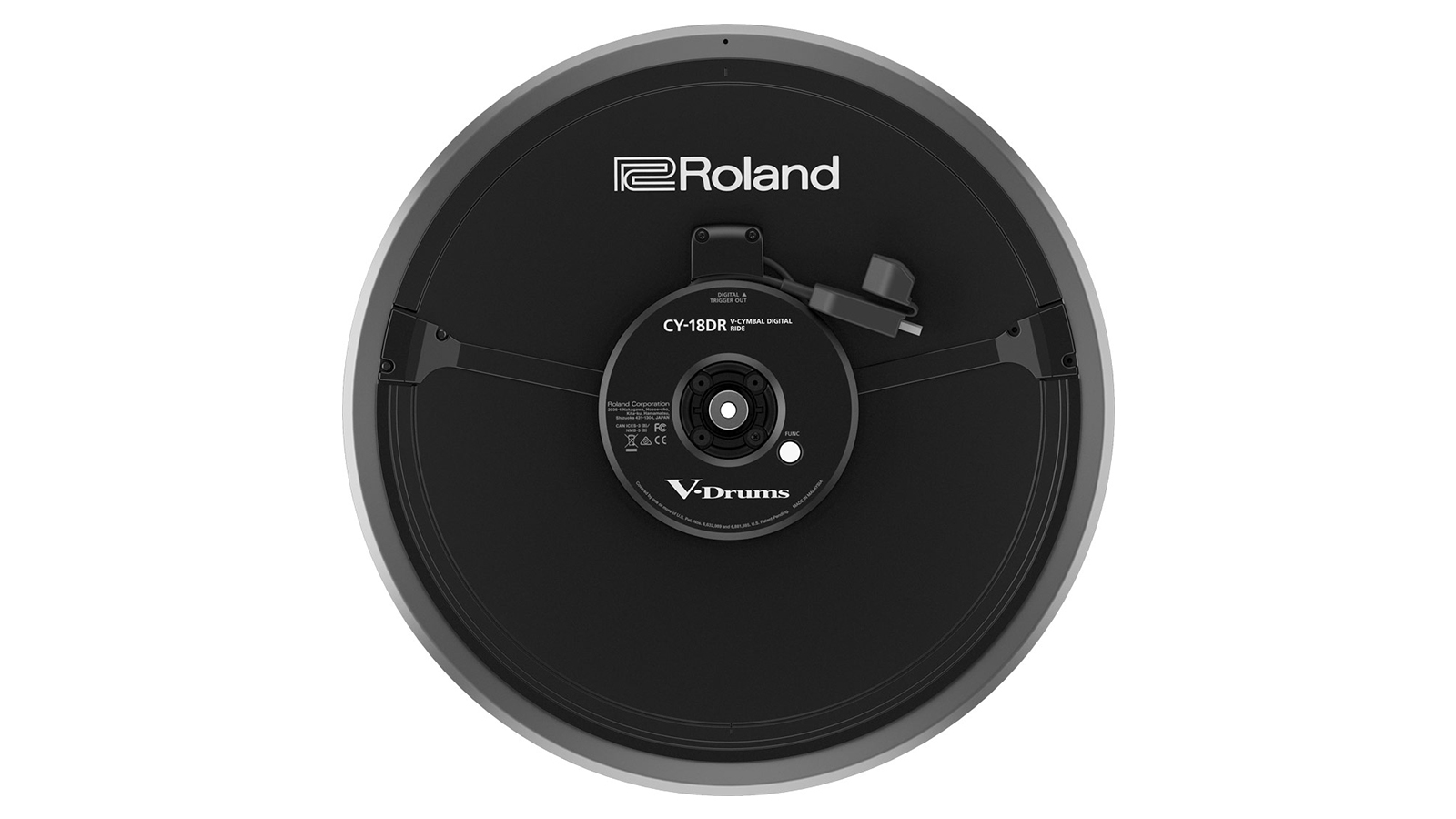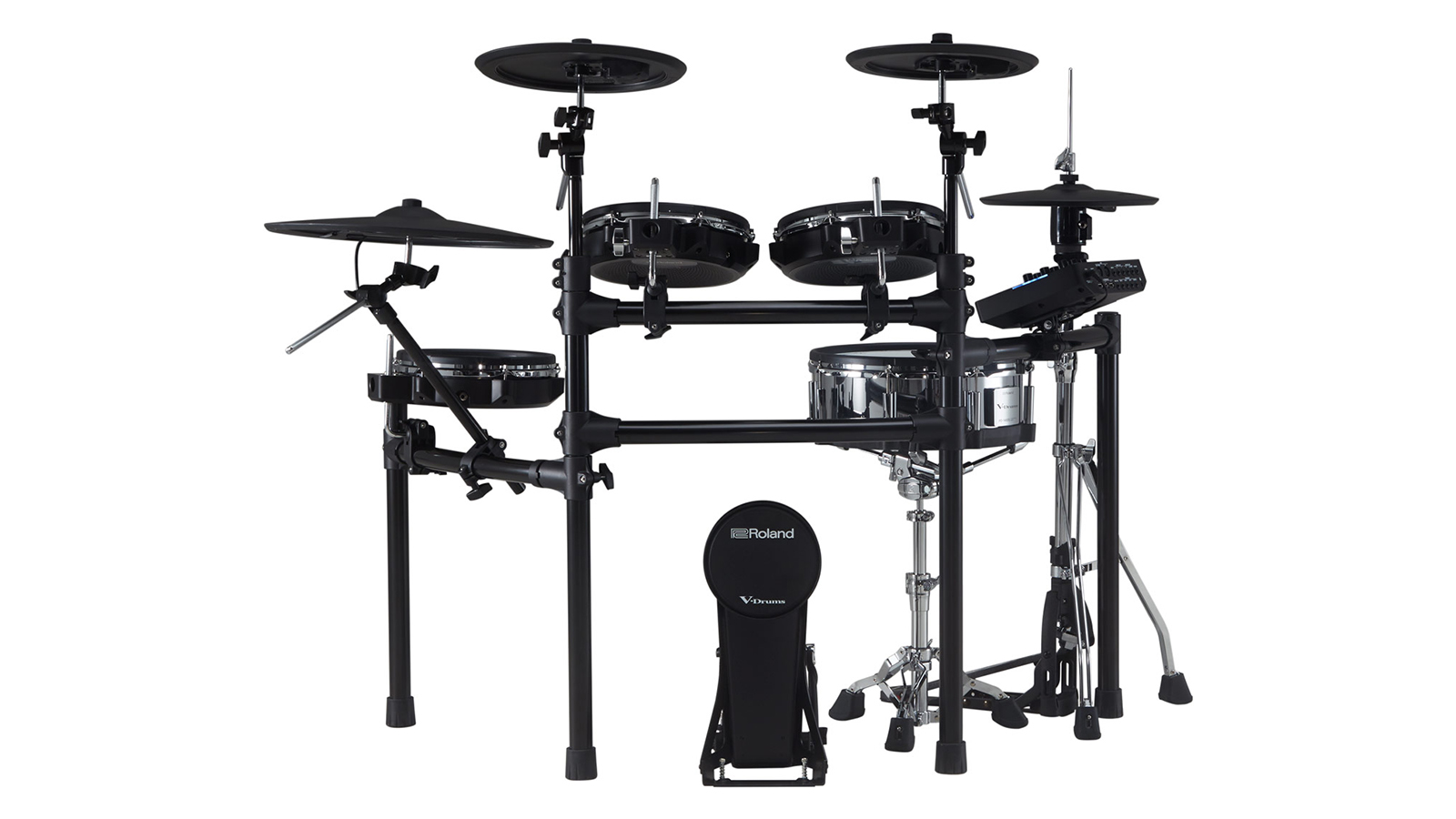MusicRadar Verdict
Electronic kits are getting closer and closer to our acoustic favourites, and the Roland TD-27KV hits the sweet spot of subconscious feel, the sound it creates gelling the playing surface. Oh, and the price? It's not cheap but it's not out of the question either.
Pros
- +
The digital-sensing snare and ride pad are next-level.
- +
Load your own samples via SD Card slot.
- +
There is a built-in audio interface.
- +
Editing capabilities are exhaustive.
- +
Comprehensive range of ambience and effect controls
Cons
- -
A lot of time needed to explore features fully.
- -
It's not cheap.
MusicRadar's got your back
What is it?
2020 got off to a busy start for Roland with the launch of four new electronic drum sets at this year’s NAMM Show.
There were top-end releases, such as the three configurations of Roland's new VAD (V-Drums Acoustic Design) kits, comprising full-size and shallow-depth wooden shells based around the new TD-27 module.
The TD-27KV kit, meanwhile, falls into the mid-priced bracket – at least for Roland – and presents a more traditional-looking electronic drum kit.
Let's talk about what isn’t new: the excellent VH-10 hi-hat pad, KD-10 kick drum pad, and the CY-12C and CY-13R cymbal pads have been seen on other mid-range Roland kits. But everything else is new at this price-point, with the changes that are really quite profound.
- Want to read more? Take a look at the best Roland electronic drum sets
- Just starting out? Here are the best beginner electronic drum sets
Now, take a deep breath: the list of new features will make your mesh head spin.
The pads themselves are a key feature of the TD-27KV. Once upon a time, you could only find the PD-140DS snare pad (with that 14” x 4.3” shell it is more drum than pad), and CY-18DR ride cymbal pad with Roland’s TD-50 kits.
This making this the first time they’ve been bundled in with a more affordable kit. The difference with these drum-like pads is that both are equipped with Roland’s digital sensor technology, which sees positional sensors complementing the standard zone trigger, all helping to eliminate ‘hot spots’ and mis-triggers. Across the playing surface, there's a greater resolution of triggering.
Want all the hottest music and gear news, reviews, deals, features and more, direct to your inbox? Sign up here.

On the snare drum pad, there are three position sensors each on the head and rim zones, and a further trio across the bow of the ride cymbal. These digital pads have their own individual processor to capture the zone and placement of your strike without any latency. There is a lot more going on than a simple piezo trigger signal. These sensors connect to the module with what is essentially a USB cable.
Next we have the module from which the kit takes its name. I follows the same sleek, glossy aesthetic design that Roland has showcased in recent releases such as the TD-17 and TD-25: the squat faders and multi-coloured buttons of yore are gone, replaced by minimalist jog wheels, with multi-function rotary encoders keeping things clutter-free.
But this is more than just good looks, Roland has unleashed a number of features on the TD-27 that make it a 2020 drum set.
Take its branded technology, such as Prismatic Sound Modelling, and PureAcoustic Ambience Technology. PSM (a next-generation COSM-style modelling) processes the module’s raw samples to create more realistic reproductions of the sounds you’re triggering. These samples should be thought of as as your raw ingredients, with the modelling behaviour the seasoning that turns rigid wav files into something way more tasty.

The PureAcoustic Ambience Technology concerns the treatment of virtual mic placement for overhead microphone and room sounds.
Anyone who has used a drum sample pack of late will know how just much mic positions influence your kit's overall sound. Here, Roland supplies an abundance of options for room type and mic positioning, and it allows the player to sculpt distance and width with your ambient mics, and adding to the realism.
Furthermore, you can import your own samples via SD card or on-board Bluetooth... Oh, and while we’re at it, the 28-channel USB audio interface.
There is a lot of connectivity here. There's an SD card slot to the left side of the module, and a USB socket for the audio/MIDI interface. Turn the module around and you will find a DB-25 connector for ferrying the lion's share of trigger inputs from the included cable loom.
And there’s a lot more. Connect up to three digital pads. You've got four additional trigger inputs on TRS jack sockets, plus a footswitch input, allowing for a plethora of pad and controller upgrades in future.
Other features include two main outputs, plus a pair of mono direct outs for sending your signal somewhere else, plus the all-important headphone output and aux-in.
Lastly, we've got traditional 5-pin MIDI in/outs for anyone wanting to connect the module up to some MIDI-equipped hardware.
Performance and verdict
As you can see, there is a lot of spec here, and it just goes to show how much Roland can harness the power of R&D and confer technology from its flagship lines down to more affordable ranges. That's why they remain at the top of the e-kit game.
But while this abundance of features leaves us wanting for nothing in theory, it counts for little if it doesn’t bring the goods in terms of performance.
On first impressions, the digital pads are standouts, in particular the snare drum. With all this technology going on, human metrics such as size and feel could be overlooked, but with the pad positioned on our snare stand, and with a quick turn of a drum key, it was easy to forget that we’re playing an electronic drum.
So much so that instead of scrolling through kits and browsing spec, it kept our focus locked on the different snares on offer, desperately trying to fool it into falling over with some rudimental snare practice.
Of course, the pad was victorious, and after playing around with a myriad of different snare types, virtual head choices, plus muffling and tuning for far too long, we remembered that there was rest of the kit to explore.
Another thing to note is the automatic cross-stick switching. Just play like you would on a real snare and it reacts as you’d expect. No X-Stick settings here, thank you.

To anyone who is used to playing smaller pads on affordable e-kits, the ride cymbal is a revelation – it's not just the bow sensing tech, which together translates into a realistic playing experience, it's the physical size and weight.
There is less margin for mis-strikes when jumping between the bow and bell; everything feels ‘balanced’ and that is not often the case with smaller ride pads.
Sound-wise, there is typically a trade-off. To have the memory and flexibility that software sample collections offer available in the hardware itself is still not cost-effective. However what's on offer here is not generic. These samples been captured in top-flight studios with tunings that are designed to complement each voice.
Roland has done a excellent job of presenting the best of its sounds in the presets, giving you some solid foundations on which to build on if you don't mind getting your hands dirty in the editing screens.
It’s a densely-loaded module, with studio-grade effects and parameters to match. There is a whole world of signal routing options – not to mention the many voices and their associated editable functions.
The whole package is deep, and it requires some investment in terms of time. But then we must remember that creating world-class drum sounds from pads and a brain isn’t a simple undertaking. As ever, the sonic rewards are there for the taking if you are willing to put that time in.

The Roland TD-17 was hard to fault. The TD-27 takes the convenience of features such as Bluetooth and sample import and builds on it with some extremely important features that go way beyond the sound in your headphones.
Gone are the undersized pads that attach to mere spindly frames as some glorified sample play-back devices that you just happen to aim a stick at. This shows us a where midfield electronic kits are heading.
MusicRadar verdict: Electronic kits are getting closer and closer to our acoustic favourites, and the Roland TD-27KV hits the sweet spot of subconscious feel, the sound it creates gelling the playing surface. Oh, and the price? It's not cheap but it's not out of the question either.
Hands-on demos
Thomann Drum Bash
Guitar Center
Roland
Sweetwater
Specifications
- Pads: PD-140DS digital snare pad (dual zone plus X-stick), PDX-100 tom pads (dual zone) x 3, VH-10 hi-hat pad, CY-12C & CY-13R cymbal pads, CY-18DR digital ride cymbal pad (three-zone), KD-10 bass drum pad
- Sounds: 728
- Presets: 55 factory kits/45 user slots
- User sample memory: Up to 500
- Effects: Pad Compressor (each pad), pad EQ (each pad), Overhead Mic Simulator, Room/Reverb, Multi-Effects: 3 chains 30 available effect types, master compressor, master EQ
- Connections: Trigger connector loom (DB-25), trigger input x4, digital trigger input x3 (USB A), master output, direct outputs x2, headphones, aux input, MIDI in/out/thru, USB audio, footswitch, SD card, power
Further reading
- The best electronic drum sets for all budgets
- The best electronic drum sets for kids
- Explore the best bass drum pedals for all abilities
- Check out our pick of the best drumsticks
- The best studio headphones: great choices for drummers

Stuart has been working for guitar publications since 2008, beginning his career as Reviews Editor for Total Guitar before becoming Editor for six years. During this time, he and the team brought the magazine into the modern age with digital editions, a Youtube channel and the Apple chart-bothering Total Guitar Podcast. Stuart has also served as a freelance writer for Guitar World, Guitarist and MusicRadar reviewing hundreds of products spanning everything from acoustic guitars to valve amps, modelers and plugins. When not spouting his opinions on the best new gear, Stuart has been reminded on many occasions that the 'never meet your heroes' rule is entirely wrong, clocking-up interviews with the likes of Eddie Van Halen, Foo Fighters, Green Day and many, many more.
